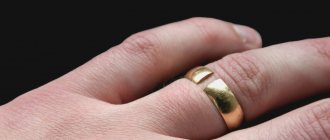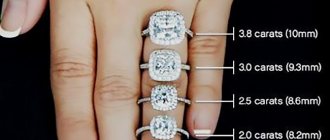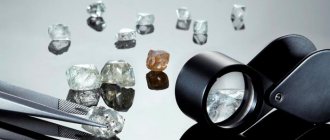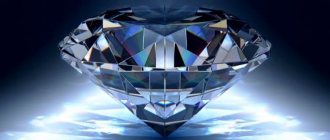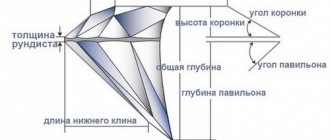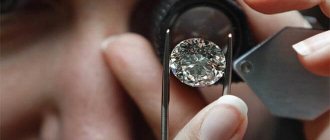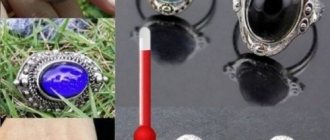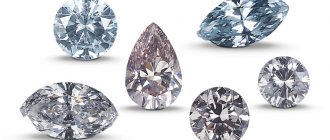How big is a one-carat diamond?
A carat is a measure of weight, and one carat is equal to 200 milligrams or 0.2 grams.
How big a one-carat diamond looks depends on its size. These dimensions, in turn, depend on the cut of the stone.
Let's look at the approximate measurements of a one-carat stone depending on its cut:
- Round cut: approximately 6.5mm in diameter
- Square cut, princess and asscher: approximately 5.5mm long
- (Rectangular) Emerald Cut : Approximately 6.5mm long x 5mm wide (these sides may vary)
- Radiant and cushion cut: approximately 6.0-6.5 by 5.0-5.5 mm
- Oval and Pear Cut: Approximately 8.0-8.5mm long and 5.0-5.5mm wide
- Marquise cut: approximately 10mm long x 5mm wide
Please keep in mind that all of these numbers are approximate and the actual size may vary depending on the proportions of the particular stone.
Report by form
The final cost of a diamond is determined by four main factors: weight (carat), color (color), clarity (clarity) and cut (cut). These parameters are conventionally called 4C; they were introduced by the Gemological Institute of America. Globally, one carat is equal to approximately 0.2 grams, and the higher the carat, the more expensive the stone. All diamonds up to 0.3 carats are considered small, up to 1 carat - medium, and those weighing more than 1 carat - large. Useful life hack: many MIUZ clients prefer 0.7 carat stones, since they are nominally medium-sized, more affordable, and at the same time quite large in size.
Now about the shape - or the cut, to be more precise. Whether we like it or not, the better and more refined the cut, the more diamond the master grinds into dust - which is why you have to pay more for a good cut. On the other hand, it is the cut that provides that unique shine of a diamond, for which connoisseurs will pay any money.
Photo MIUZ
Russia is a tradition-setter here too: the so-called “Russian Cut” is known all over the world, symbolizing the highest quality of processing since Soviet times. It is noteworthy that this definition does not apply to the origin of the stone. For example, in the USA, a diamond of any country of origin, but with an excellent cut, is called Russian Cut. Historically, cutting for many jewelry brands is most often done in India: according to average estimates, this country accounts for up to 90% of all stones on the market. There are hundreds of manufactories and family businesses in India that specialize in cutting diamonds.
The MIUZ diamond collection offers eight fancy cut options: pear, emerald, round, cushion, marquise, oval, princess and radiant - each of them can rightfully be called Russian Cut.
How to make a diamond in a ring appear larger?
There are several factors that affect how large a diamond appears when set in a ring: the type of setting, the cut of the stone, and its shape.
How does the ring setting affect the size of the diamond?
Some settings leave more of the diamond surface visible than others.
For example, prongs do not cover the same amount of the stone's surface as rim or channel settings.
A setting that holds the diamond with four or six prongs can be a good choice if you want to show off as much of your stone as possible and make it appear larger.
Diamond shape and its effect on size.
Some diamond shapes tend to look larger than others, even if they have the same carat weight.
If you want to create the illusion of size, look for wide shapes. For example, a square asscher cut diamond will appear larger than a narrow marquise cut diamond.
However, it's not just the shape that matters when it comes to appearance.
Sometimes, the way a diamond is cut can make it look smaller even though its shape is wide and square. This is why you should also consider the importance of cut.
Cut as a factor in diamond size.
The way a diamond is cut can greatly affect how it looks. Deeper cuts appear smaller than shallower ones, as long as the stones being compared are of the same carat weight.
For example, the princess cut has more depth compared to the emerald cut.
In general, if you want a diamond whose surface appears larger when set in a ring, look for shallow cut stones.
Don't forget, however, that each cut has certain ideal proportions, and if the depth of the diamond you buy deviates significantly from the standard for a particular cut, its brilliance may be reduced.
This is especially true for brilliant cuts such as round.
Diamond size and finger size.
Finally, be sure to consider the wearer's hand when choosing the size of the diamond in the ring.
Wide fingers can make a diamond appear smaller than it appears when placed on a hand with thinner fingers.
Also, consider the fact that elongated diamond shapes make the fingers appear longer, while wider shapes emphasize the width of the hand.
What is carat value?
Carat weight is used to measure all gemstones. The word "carat" comes from the Greek name for the seeds of the carob tree, which were known to be of equal weight.
As the carat value increases, the price of the stone also rises. When buying a diamond, you can save a lot by choosing one that does not fall into the main sizes: for example, 0.40 ct instead of 0.50 ct or 0.95 ct instead of 1 ct.
Additionally, the carat size does not match the visual proportions. So, for example, a 1 ct diamond and a sapphire will not look the same, but their weight on a special carat scale will be identical. This is because different gemstones have different densities and a diamond will visually appear larger than a sapphire. Do not forget that the setting can also affect the optical magnification of the gemstone (therefore, the halo style, when the central stone is surrounded by a halo of smaller ones, does not go out of fashion).
Why aren't diamonds sold in standard carat weights?
Did you know that all those 1-carat diamonds may not weigh exactly 1 carat? Stated values are approximate.
Although diamond carat weight is expressed in standard values such as 0.5, 0.75, 1, etc., in reality, it is rare to have a stone that weighs exactly one of these numbers.
A one-carat diamond can actually be 0.95 or 1.05 carats. This is why you shouldn't expect two diamonds with the same carat value to be exactly identical in weight.
In fact, it is completely normal that the diamond weight is not an exact number and it is usually noted that this number is an approximation.
This is normal practice and is usually not hidden; you can always find the exact carat value on the diamond certificate (or grading report).
It is often impossible to cut a diamond so that its carats exactly correspond to the standard size.
A jeweler cutting a diamond crystal will generally try to obtain one or more stones that are of the highest possible quality.
For example, a carat can be deliberately reduced by cutting out segments that contain many natural imperfections, thereby improving the clarity of the diamond.
Or the jeweler may want to get rid of some parts of the crystal to create a more proportional cut, which increases the sparkle of the stone.
However, the carver will also try to use as many raw materials as possible and minimize waste. As a result, the cut stone will have a weight that will be close to one of the standard values, but there will always be some deviations.
What is the normal carat deviation?
Typically, the actual weight of a diamond will vary between 0.06 and 0.08 of its advertised value.
For example, a 0.94 carat diamond would be sold as a one carat stone. Or, a diamond that is stated to be 0.75 carats may actually be closer to the 0.8 number.
You can always ask the salesperson at the jewelry store about the exact weight of the diamond he shows you. You can also check this number on the diamond grading report - it should be mentioned there.
Features of 9 carat gold
In our country, 375 standard is not very widespread: it is not prestigious and not very profitable in terms of pure precious metal. It is rather poorly represented in the assortment of most domestic jewelry stores. Typically, 375 gold items have a rather dull color. In addition, since the main component in them is not gold, but other metals that are not so chemically inert, the constant wearing of such jewelry cannot exclude the occurrence of allergic irritations on the skin.
Copper, silver, and sometimes palladium are usually used as alloys.
The color, depending on their ratio, varies from deep red to deep yellow. Palladium, despite its high cost, is used as an additive to this relatively cheap alloy because it has a strong effect on the color of the metal: it can completely lighten six times the amount of pure gold. This is especially important for the rather dull 375 metal. The most common options for the ratio of ligature additives are:
- Of the 62.5% attributable to the alloy, 2.5% silver, 60% copper. The color of the metal is deep red.
- 10.5% silver, 52% copper. Color - red.
- 16.5% silver, 46% copper. Color - dark yellow.
- 10% silver, 48.7% copper, 3.8% palladium. The color is close to the natural color of high-grade gold. This alloy (or a composition close to it) is used to make wedding rings.
How visible is the difference in carat weight?
Of course, if you compare a 0.75 carat diamond to a one carat diamond, you will notice the difference.
However, when the deviation is between 0.05 and 0.1 carats, it is difficult to detect. If a 0.95 carat diamond is placed next to a 1.02 carat diamond, for example, you will likely have a very hard time telling the difference.
You should expect to pay a little more for a diamond that is slightly above the 1-carat or 0.5-carat mark (or above any standard value).
This works both ways. If the diamond is 0.05 less than 1 carat or some other standard value, then you will pay less.
How important is carat when it comes to price?
Carat weight is one of the most important factors in determining the price of diamonds.
Increasing the carat weight will result in a disproportionate increase in the cost of the stone.
For example, a two-carat stone will not cost twice as much as a one-carat stone; the actual price difference will likely be three or four times that.
The most popular carat values are usually round numbers (1 ct, 2, etc.) and their fractions (0.25, 0.50, 0.75, 1.50, etc.).
Knowing these in-demand quantities is important because it can help you save money on your purchase.
Carat sample system
The gold hallmark system is closely interconnected with the karat system, as demonstrated by the formula described above. So, 18 carats corresponds to the marking 750, 14 - 585, etc.
Many people interested in precious metals may wonder about the existence of an alloy with a value of 22 units. If we convert this figure into grams using the formula 1000 * 22/24, we can get the number 916, which corresponds to 22 carats. This alloy has the following features:
- The cost of a gram of such raw materials in Russia ranges from 1900 to 2100 rubles.
- The alloy has a rich yellow color, since one kilogram of it contains at least 916 grams of aurum and only 84 grams of alloy - impurities represented by silver and copper.
- Abroad, in particular in the East and in some European countries, you can easily find jewelry with this marking for sale in jewelry stores. In Russia and the CIS countries, such raw materials are practically not used in the production of jewelry. Any aurum marked 900 or more is used as a raw material for the manufacture of some orthodontic prostheses, parts in the field of microelectronics, etc.
If a person decides to purchase jewelry abroad, then he must not only understand how the units of value of the metal relate to each other. When buying jewelry abroad, preference should be given to trusted jewelry stores that have an impeccable reputation among buyers. However, this rule also applies if the buyer gives preference to domestic jewelry.

